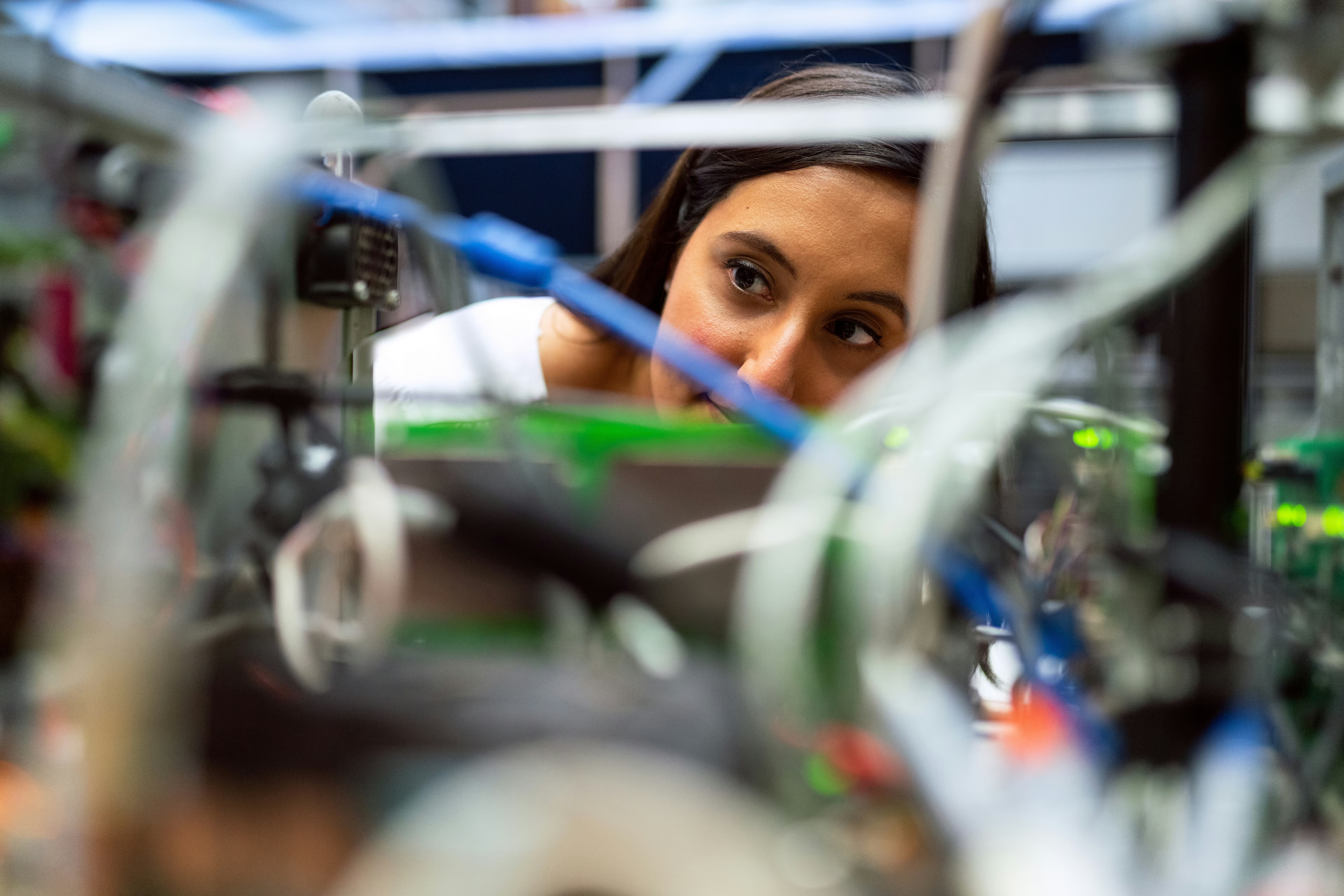If Europe is to fully benefit from AI, the technology must be fully embedded in industrial processes.
For companies struggling to deploy AI, the key is identifying the concrete business problems it can solve.
Well-calibrated regulation should also accelerate the implementation of application-layer AI.
세계경제포럼, 2025년 8월 25일 게시
Kai Zenner
Head of Office and Digital Policy Adviser for MEP Axel Voss, European Parliament
Benedikt Gieger
Founding Curator and Global Shaper, Heidelberg Hub, Global Shapers Community

AI is no longer a promise of the future, but the defining technology of our time. These days manufacturers are not impressed by AI pilot projects; they expect solutions that deliver measurable impact and a rapid return on investment (ROI).
For Europe’s industrial backbone, AI offers a once-in-a-generation opportunity to reclaim its strategic autonomy, competitiveness and innovation leadership – capabilities that, in some areas, have eroded over the past two decades. If we do not start to embrace AI decisively, that opportunity may pass us by.
According to the World Economic Forum, AI could add up to $15.7 trillion to the global economy by 2030, with nearly half of that driven by productivity gains alone. European manufacturers, who still generate nearly 15% of the EU’s GDP, could significantly increase this share if they lead the transformation rather than follow it.
Have you read?
- How Europe can harness digitalization to become a leader in business AI
- Europe has taken a major step towards regulating AI
- How to develop more European AI startups
But let’s be clear: this effort cannot be about adopting chatbots. It must focus on embedding AI into the critical processes that drive European industry, across entire value chains, from design to delivery. As the World Economic Forum’s Global Lighthouse Network has shown, AI is already powering smart factories worldwide. Europe’s task is to ensure that its manufacturers – large and small – have not just the ambition but also the tools, talent and trust to compete at the global frontier.
The application layer advantage
Despite Europe’s leadership in industrial know-how and deep domain expertise, too many companies struggle to cross the chasm from experimentation to scaled deployment. A recent Bitkom study in Germany revealed that only around 20% of companies successfully use AI in daily operations, while nearly 80% remain stuck in the pilot stage or have yet to start.
The main challenge lies in deployment; the key to solving it is the application layer. Europe must shift focus from building models for their own sake to embedding AI in solutions that solve concrete business problems. In other words, we need less AI as a technology showcase and more AI as an everyday business tool. AI applications should be the starting point for companies, especially in regulated and complex sectors such as manufacturing, healthcare and mobility. For example, the Siemens Digital Lighthouse factory in Erlangen deployed AI, digital twins and robotics across more than 100 use cases, achieving a 69% boost in productivity and a 42% reduction in energy use over four years.
Here, Europe has a global advantage: industry-specific knowledge and high-quality domain data. By embedding that expertise into AI-powered applications in areas like operations, procurement or finance, we can turn European complexity into European competitiveness. Often-overlooked tabular models (trained on structured data instead of unstructured data) allow manufacturers to harness data efficiently, which is particularly valuable where auditability is essential.
While industry-specific foundation models such as large language models (LLMs) promise future capabilities, they demand massive investment and carry considerable risk. Rather than chasing scale in model development, Europe should double down on AI applications that match the immediate needs of key industries. These can deliver rapid business impact, operate securely, remain fully auditable and thrive in B2B environments where liability, compliance and interoperability are non-negotiable. This pragmatic, bottom-up approach would allow Europe to leverage its deep domain knowledge to create user-centric AI solutions with global relevance.
At the same time, no single player can build this future alone. An open and collaborative AI ecosystem, linking frontier model providers, IT leaders, startups and SMEs, is essential to turning advanced technologies into tangible results. Innovation thrives in partnerships, and Europe’s strength lies in connecting the dots across the AI value chain.
SMEs in particular benefit from ready-to-use, plug-and-play AI tools that integrate into existing systems without requiring deep technical expertise. Adoption must be made as seamless as possible, with scalable, user-friendly solutions that deliver a clear and provable ROI from the outset. This creates a virtuous cycle: as more companies adopt AI, demand for high-quality models grows, driving further investment in Europe’s foundational AI capacity. This is more than a technology adoption curve, it is a competitiveness curve. Bottom-up adoption becomes a pathway to true technological strength.
Regulation for trust and innovation
As AI adoption accelerates, regulation should not be a roadblock but a strategic lever that safeguards trust while enabling responsible innovation. Well-calibrated, it will not only set the guardrails for safety, but also accelerate the deployment of application-layer AI in the industrial sectors, turning cutting-edge technology into day-to-day competitiveness.
The EU AI Act, the world’s first comprehensive AI law, is designed to strengthen global trust by setting a high bar for safety, transparency and accountability. Crucially, it harmonizes rules across the EU member states, preventing a patchwork of national laws that could fragment the single market and deter investment. For manufacturers, this harmonization is essential to ensure consistency, legal certainty and a level playing field. Without it, legal fragmentation and uncertainty could undermine competitiveness and slow the adoption of AI.
However, like any pioneering regulation, the AI Act must be interpreted and applied with real-world complexities in mind. If applied in an overly rigid or one-size-fits-all manner, it risks unintentionally stifling innovation – especially in fast-evolving areas such as agentic AI. Industrial AI requires a different regulatory lens than consumer-facing AI, as it operates in controlled environments, under contractual obligations and often within certified safety frameworks
Three additional priorities deserve attention. First, enforcement capacity must match legislative ambition. Without well-resourced and technically skilled regulators, even the most forward-looking rules risk remaining on paper. Second, regulation should integrate with existing international industrial standards – such as ISO, IEC or sector-specific safety certifications – so that compliance is streamlined rather than duplicated. And third, Europe’s regulatory implementation pace must match that of its global competitors. The United States and China are rapidly shaping their own AI frameworks; if Europe moves too slowly, it risks ceding both market share and standard-setting power in the technologies that will define the next industrial era.
Regulation should therefore be adaptive, recognizing that compliance for industrial AI can be achieved through sector-specific standards, certifications and best practices. By combining robust safeguards with regulatory flexibility, Europe can encourage innovation while ensuring that AI remains safe, accountable and aligned with its norms and values.
A strategy that works for Europe
Europe’s AI strategy for manufacturers should rest on three pillars:
- Prioritize guidance and best practices for industrial AI, giving companies clarity without imposing excessive compliance burdens.
- Invest in regulatory sandboxes that allow safe experimentation with advanced AI systems, enabling innovation within a controlled environment.
- Coordinate closely with international partners to align AI standards and certification schemes, ensuring European companies remain competitive in global supply chains.
By following this approach, Europe can turn its manufacturing base into an AI powerhouse; not by chasing brute-force compute capacities, but by mastering high-value, sector-specific AI where the continent can set the global standard. This means excelling in meaningful, responsible and scalable AI deployment that plays to its industrial strengths. This is how Europe can convert its deep domain expertise, world-class engineering and high standards into a decisive global advantage.
The next industrial revolution is already underway. Europe has the tools, the talent, and the trust to lead, if it chooses to act. If it leads with purpose, it can shape not just the future of its factories, but the future of global industry.
All expressed views are personal and represent neither the position of the European Parliament nor of the EPP Group.


